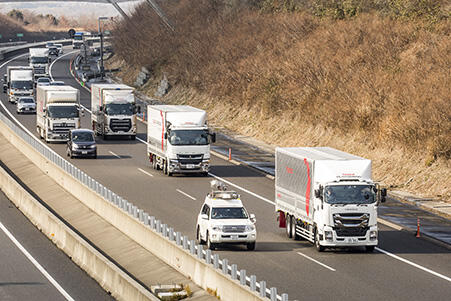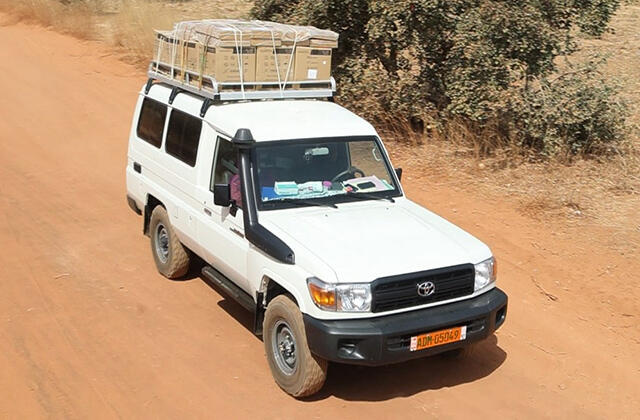Turning the Changes to the Automobile Industry into Growth Opportunities Taking on the Challenges of CASE -First Part-

2018年07月01日
- Quantum Computing
- Connected
- High-precision Satellite Positioning
- Connected
- Autonomous
- Truck Platooning
- Autonomous
- Ride Sharing
- Shared
- Virtual Power Plants (VPPs)
- Electric
- Lithium Resource Development
- Electric
Creating Value-added Business through Quantum Computing-based Optimization Technologies
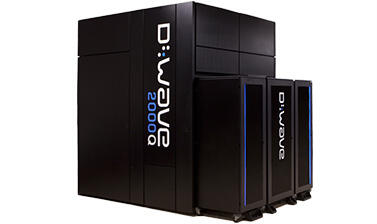
Quantum computers are specialized machines used for combination optimization, determining how to best combine options from a large option pool to achieve the greatest efficiency and profit in specified scenarios. Quantum computers of D-Wave Systems (Canada) are innovative computers that use the natural phenomenon of quantum annealing to solve optimization problems incredibly quick. In November 2017, Toyota Tsusho concluded a cooperation memorandum with D-Wave Systems with the aim of jointly creating business in Japan.[Click here to see details.]
Furthermore, in December 2017 in Bangkok, Thailand, we began a joint trial together with Denso of the world’s first commercial application of the system to transportation.
[Click here to see details.]
The system gathers large amounts of probe data (location and time information) from GPS receivers mounted in probe cars*1 such as taxis operating within Bangkok. This information is then processed by D-Wave Systems’ quantum computers connected via the cloud. This testing will assist us with the proposal of new applications such as those that use quantum computers to alleviate traffic congestion or determine priority routes for emergency vehicles.
Quantum computers will be used in solutions that work with the growing amounts of data produced by the IoT and the spread of machine learning, meeting real-time optimization needs. They are believed to have tremendous potential for use in diverse fields, from the next-generation automotive sector to logistics, finance, medicine, the environment, and more. We are working to provide Japanese customers with greater value via the implementation of optimized technologies.
- *1Vehicles with onboard GPS receiver.
Expanding the Centimeter-class High-precision Satellite Positioning Business Market Using the Michibiki Quasi-zenith Satellite System (QZSS)*2
In March 2018, Toyota Tsusho carried out a demonstration project in Bangkok, Thailand, that utilized Michibiki and MADOCA*3 to gather lane-class probe information—which cannot be done using existing systems—with the aim of realizing the practical application of a lane-level high-accuracy route guidance system.[Click here to see details.]
The demonstration project equipped probe cars that operate in urban Bangkok with high-accuracy multi-frequency multi-GNSS*4 receivers that can receive signals from Michibiki and correction data from MADOCA. Based on centimeter-class probe data (location and time information), the project sought to evaluate the technologies used by systems that generate lane-level high-accuracy traffic congestion information, and in systems that distribute high-accuracy route guidance. The project also aimed to provide optimal route guidance.
Through this demonstration, the Toyota Tsusho Group sought both to further contribute to alleviating traffic congestion in Thailand by improving its traffic information services, and to expand its business in fields that utilize high-accuracy positioning technologies.
- *2A Japanese satellite positioning system comprised primarily of quasi-zenith satellites (the system uses radio waves generated by the satellites to calculate position information)
- *3Short for “Multi-GNSS Advanced Demonstration tool for Orbit and Clock Analysis” and developed by the Japan Aerospace Exploration Agency (JAXA), MADOCA is a system that generates satellite signal correction data. It is a precise orbit and clock determination software that supports multiple GNSSs.
- *4Global Navigation Satellite System: GNSS is a collective term for global satellite positioning systems such as GPS, GLONASS, Galileo, and QZSS.
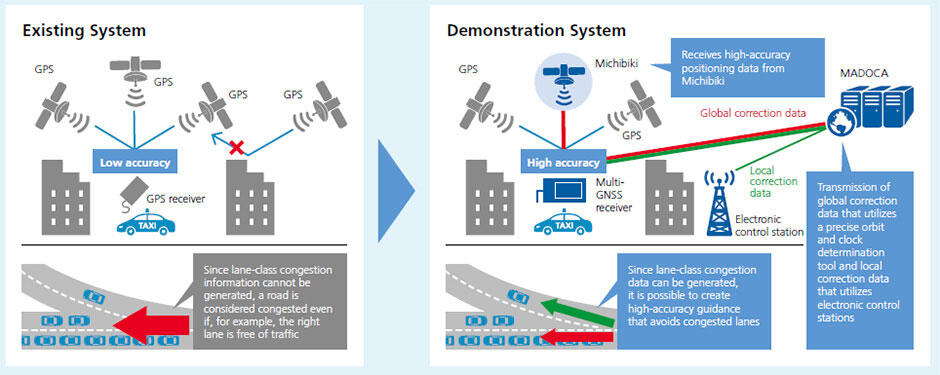
Toyota Tsusho has invested in Magellan Systems Japan (Magellan)[Click here to see details.]and GPAS with the aim of collaborating in business areas that utilize high-accuracy satellite positioning technologies.
Satellite positioning is composed of three areas (the satellite, terrestrial, and user areas), and through our investment in these companies we are participating in two of these—the terrestrial and user areas. Our aim is to develop the nascent market for high-precision satellite positioning businesses using QZSS. We will contribute via these services to the resolution of societal problems, including the realization of a safe and economical road traffic society, and both energy and labor savings in the agricultural and construction industries, where an aging workforce and shortage of labor are growing concerns.
TSQUARE Traffic Congestion Information Provision Service
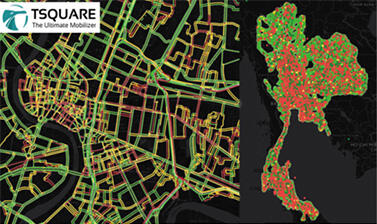
TSQUARE, a service that provides traffic congestion information, was used as a platform for the quantum computer and high-precision satellite positioning demonstration projects discussed in this feature. It was launched in 2012 by TOYOTA TSUSHO NEXTY ELECTRONICS (THAILAND) CO., LTD. for use in Thailand, which has one of the highest levels of traffic congestion in the world. Probe data (location and time information) collected from roughly 130,000 probe cars such as taxis with GPS receivers is used to generate traffic congestion information. This information is then relayed via a traffic congestion application as well as supplied to automobile manufacturers, helping contribute to the alleviation of Thailand’s traffic congestion problems.
Achieving Real-world Truck Platooning
Toyota Tsusho has been contracted by the Ministry of Economy, Trade and Industry and the Ministry of Land, manufacture, transport and tourism for the Research and Development/Demonstration Project for Implementation of an Advanced Autonomous Driving System in Society: Demonstration Tests on Social Implementation of Truck Platooning, and we are carrying out research and development related to truck platooning.[Click here to see details.]
As part of this project, in January 2018 we began the world’s first trial of manned truck platooning. In addition to improving management efficiency by saving manpower and reducing CO2 emissions, we aim to realize a safe, comfortable mobility society by addressing the shortage of drivers and enhancing safety.
